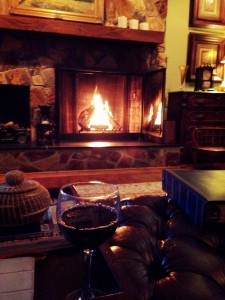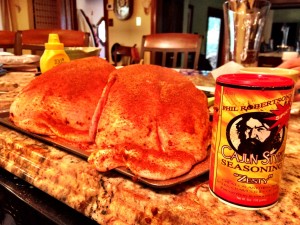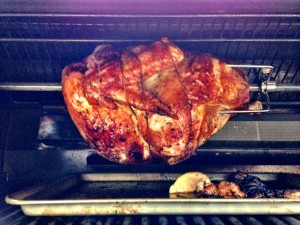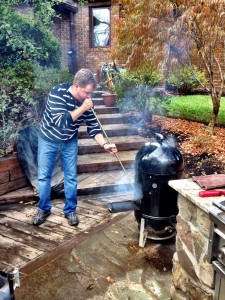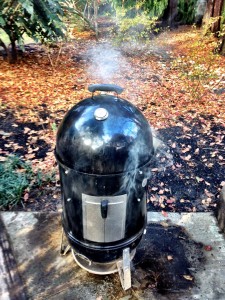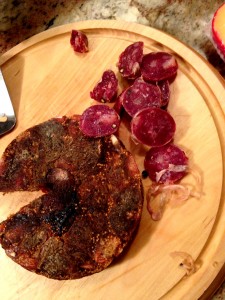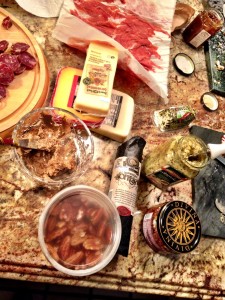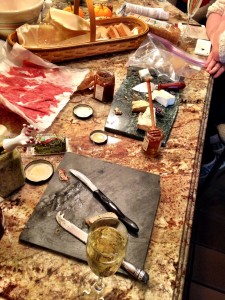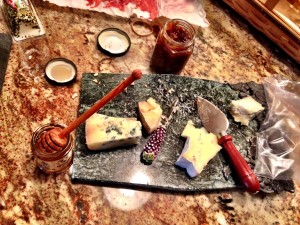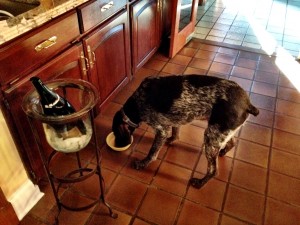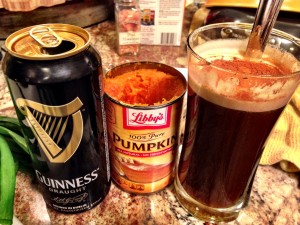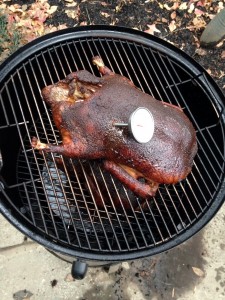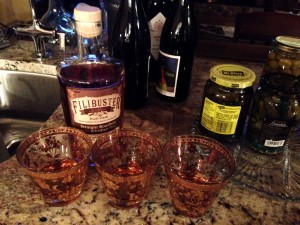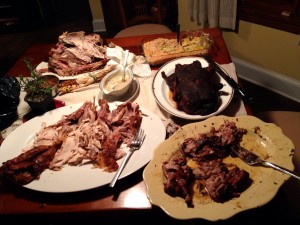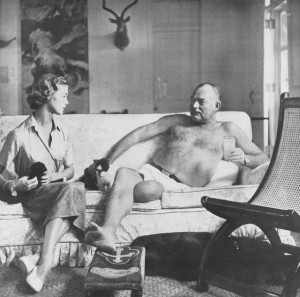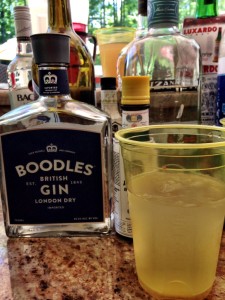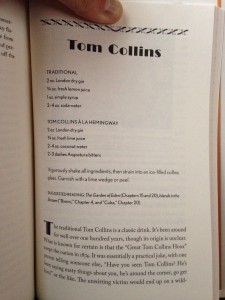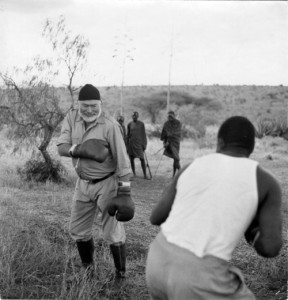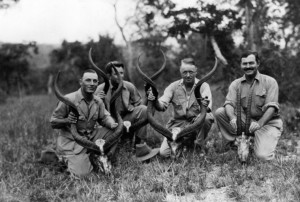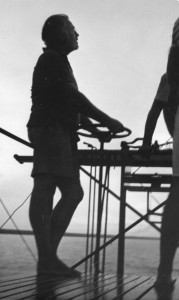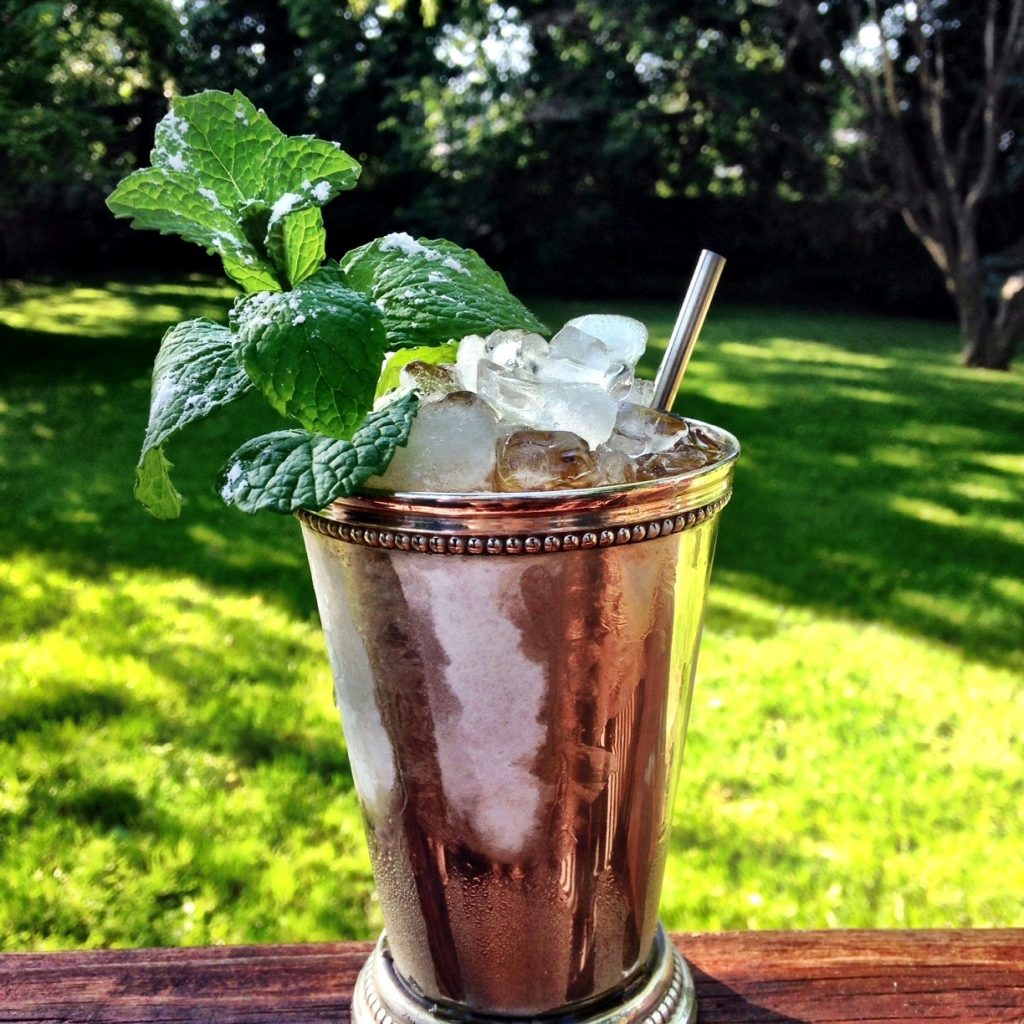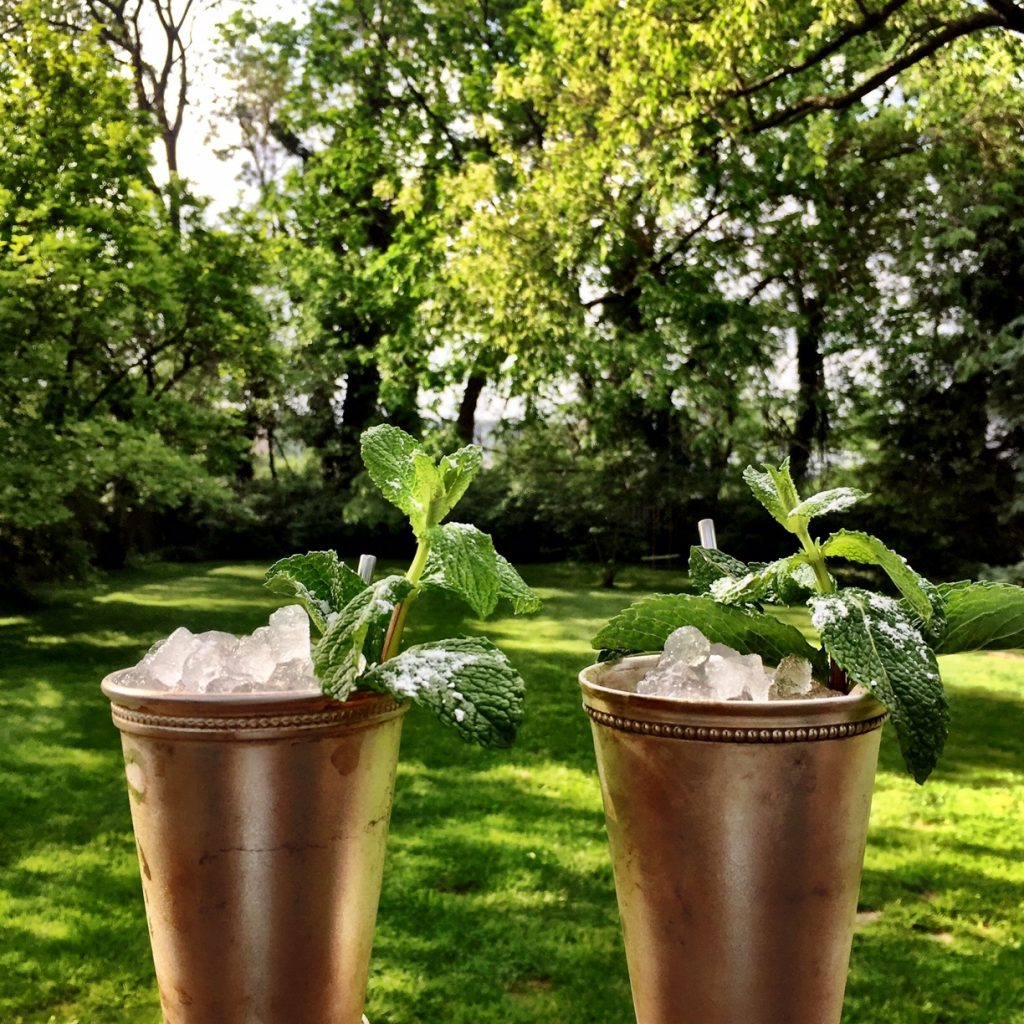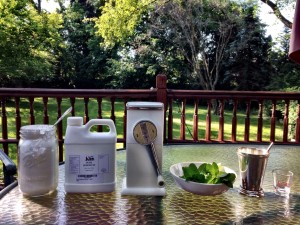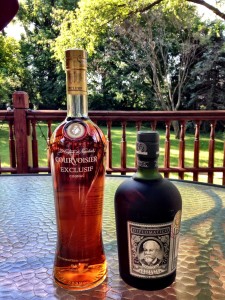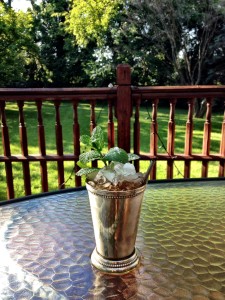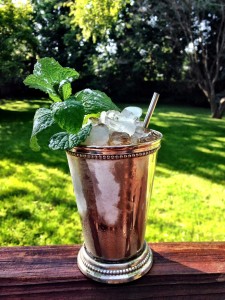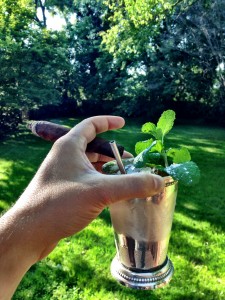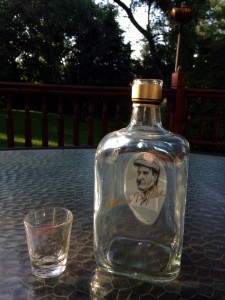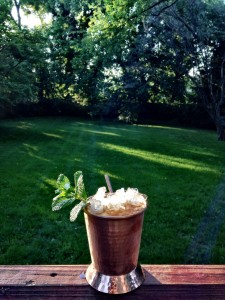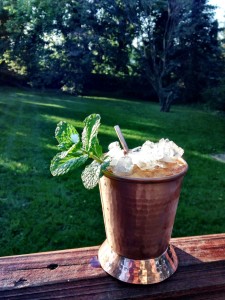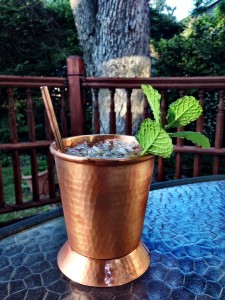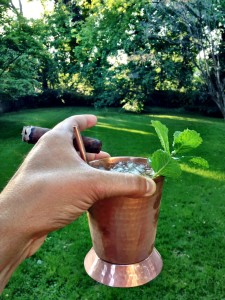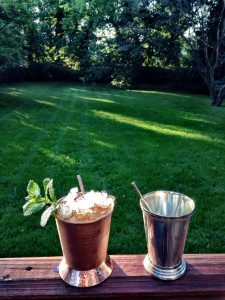Happy Thanksgiving
Thursday I had a little wine, and headed out into the cold. I got the smoker going, and threw in the ducks.
FJ got the turkey on the rotisserie.
If you’re still doing some holiday shopping, check out that pic above of my dad using his blo-poke. Its handy by the hearth, but also very useful for smoking/grilling. You can get one at Orvis, but they’re cheaper factory direct and the guy that makes them even called me to make sure I was happy with mine.
Then we headed inside to enjoy the meat and cheese we scored at arrowine.
FJ’s turkey came out great, and we didn’t have any rotisserie motor failures this year.
Otto is enjoying some sauce next to some champs that Kate will be able to saber next year (practice makes perfect…).
I know its been a while, but how about a (beer) cocktail recipe. I had this at McCormick & Schmick’s a couple weeks ago. Their version included sugar, or some sweetener. I prefer mine with straight pumpkin. Pour a guinness into a glass. Add about 1.5 oz pumpkin puree. Stir it in well. Top with some pumpkin pie spice. Enjoy.
This was my great uncle’s pipe.
My sister’s bf Ry brought me some holiday brown sauce, so I poured the guys a couple fingers. Then it was time for dinner.
Everything came out great. My cousin’s fiance came in a little late, so we had a second round much later that evening. It was great to finally meet Dan.
by rsiv withWarning: count(): Parameter must be an array or an object that implements Countable in /home/bonviv6/public_html/wp-includes/class-wp-comment-query.php on line 405
Warning: count(): Parameter must be an array or an object that implements Countable in /home/bonviv6/public_html/wp-includes/class-wp-comment-query.php on line 405
no comments yet
The Hemingway Tom Collins
I just got back from Cuba, and finished reading Islands in the Stream. In the book, Hemingway enjoys a Tom Collins, with his own spin on the drink. For a car trip from his Finca to Havana, he has his house man fix him a Tom Collins a la Hemingway:
2oz London dry gin, 3/4oz lime juice, 2-4oz coconut water, 2-3 dashes angostura bitters. Bonus points if its a roadie, wrapped in a paper towel, held in place with a rubber band.
If you’re unfamiliar with a traditional Tom Collins, Hemingway’s version basically substitutes lime for lemon, and adds coconut water. While reading the book, I was unconvinced that gin and coconut water would pair well. I like both individually, but they don’t sound appealing together. However, after I finished the book, and I was going though, To Have and Have Another, I saw the recipe again, and decided to give it a try. My first impression is that the lime (instead of the traditional lemon) is a substantial improvement. However, its the coconut water that really sets the drink off. Its very subtle. At 2 to 4+ ounces, the coconut water does not overpower the other flavors, and is really in the background. I also find that it makes the drink much more refreshing. If one were to enjoy just one cocktail all day, I don’t think it would matter much what was in the drink, but if going on a marathon drinking binge a la Hemingway, especially if in the tropics out on a boat, a little coconut water goes a long way. For the uninitiated, coconut water is nature’s sports drink. Its has more potassium and electrolytes than gatorade, without the bane of Hemingway’s existence, excess (added) sugar. This summer, if you’re out on the stream on the flying bridge of your fishing vessel, out on an adventure, at the pool, or just chillin at home, try fixing up the Hemingway Tom Collins.
by rsiv withWarning: count(): Parameter must be an array or an object that implements Countable in /home/bonviv6/public_html/wp-includes/class-wp-comment-query.php on line 405
Warning: count(): Parameter must be an array or an object that implements Countable in /home/bonviv6/public_html/wp-includes/class-wp-comment-query.php on line 405
no comments yet
Mint Julep Mega-Post!!! Recipes, Reference, How to videos, and Resources
- Perfect
- But better shared
I’ve long been a bourbon guy. I’ve also been a mint julep guy for quite some time. I can’t remember what exactly got me into either, but I can remember the first really good mint julep I ever had. I went to The Greenbrier many years ago and ordered a julep at the Lobby Bar. Despite The Greenbrier’s website showing a julep in a clear glass with citrus on its site and a plastic straw on another page, I recall getting a beautiful julep in a proper beaker. It was perfect or damn near anyway. There are so many reasons that its hard to get a good julep at a restaurant/bar, but I think the major obstacle is that establishments do not want to serve such a strong drink. The julep is from another time when people really drank and enjoyed the taste of hard liquor. Nowadays, most people seem to prefer that a drink have no taste of alcohol whatsoever and bars want to serve one ounce or 1.5 ounces of liquor per cocktail. I imagine its also costly to keep fresh mint on hand and employ bartenders that can craft a quality drink (as opposed to those that can only add vodka to redbull). If I’m at a bar thats not known for good cocktails, for say, a work happy hour, odds are I’ll order a bourbon or scotch neat. Not because I don’t want a cocktail, but because I doubt the bartenders’ ability to make a good one in a reasonable amount of time. Fortunately for me I live near Washington DC where there are plenty of excellent bartenders, and even bars with julep history. Here is the problem: If you want someone’s interpretation of a classic, by all means, enjoy a julep at any upscale bar. DC has plenty. If you find yourself north of the Mason-Dixon, Nick Nicholls (formerly of Berlin, MD) at Forest Hills Station House can serve you their interpretation from the menu, or a historically authentic julep made to order. So if you truly want the real deal you’ll probably have to make it for yourself (or have it made to your exact specifications).
So at this point, I imagine you’re wondering, “What is the correct/authentic mint julep recipe?” The answer is that it depends on the timeframe and your preferences. To truly understand the julep, and to become a champion of the julep, one must read, The Mint Julep by Richard Barksdale Harwell. In the aforementioned work, it is stated that one of the first recorded uses of the word julep in America was in 1787. It was said to contain rum, water, and sugar, and was drunk by a Virginian, in the morning. Recall that rum was quite popular in the Colonies at that time, and that whiskey did not become the most popular American spirit until quite a while later. In 1803, the julep was first described as having mint as an ingredient and this time, the spirit used was whiskey. Again, the context is a plantation in northern Virginia, and the julep is taken in the morning.
In the The Bon Vivant’s Companion (Jerry Thomas, 1862, source again is The Mint Julep by Harwell) a recipe for the Mint Julep is given, using Cognac, and a splash of Jamaica rum. Other recipes with various base spirits are given, but Cognac and Jamaica rum is given as the standard. Notice the published date (more on that later).
Elijah Craig is credited with first aging whiskey in charred barrels. This is said to have happened at his distillery, built 1789, and before his death, in 1808. By 1793, “Old Whiskey” was a term used in advertisements, and by 1814, the actual number of years the whiskey had been aged was advertised. That said, straight off the still ‘white dog’ whiskey is what predominated (Bourbon, Straight. Cowdery). Even though charred barrel aging was starting to be used, the modern practice of using brand new charred oak barrels once (and only once), would not become a standard practice until much later. 1849 is the first time whiskey is described as being red in color (Bourbon, Straight. Cowdery). At this time, whiskey was very very rarely sold in bottles. Distillers sold white whiskey to wholesalers, who then might, “rectify” it, by charcoal filtering, adding fruit, redistilling it, or some other process to improve the flavor. There were no laws about labeling, so if you could make whiskey look dark, and you could sell it as aged whiskey (Bourbon, Straight. Cowdery). After the bottled in bond act of 1897, and the invention of a bottle making machine in 1903, bottled whiskey, and guaranteed aged whiskey, would become more common. Once can experiment with unaged whiskey in a julep, but I’d wager you’re unlikely to love the result.
So now that you know a little more about the spirits that are often used as the base for the julep, lets talk about when/why one should use each.
If you want a colonial/antebellum mint julep, one that a Virginia statesman such as many of our founding father’s would have enjoyed, I suggest Madeira, Cognac, brandy, or rum. It would also be authentic to use claret (red Bordeaux) or unaged whiskey, but again, I don’t think you’ll enjoy a white dog julep, and a claret julep does not have the strength of the other options. Madeira was the preference of many of the more wealthy planters, but at around 20% alcohol or 40 proof, it is not quite as strong as a hard liquor. My suggestion is to use Cognac or brandy, but feel free to substitute any of the above options in my recipe below. I also like to add some rum for a little something extra.
Colonial / Antebellum Mint Julep
Add roughly 10 mint leaves (preferably Kentucky Colonel) to a metal beaker (Julep cup) and bruise lightly to bring out their aroma. Fill beaker with crushed ice. Add sorghum syrup (or equal parts sugar and water, heated to create a syrup) to taste. I suggest roughly a quarter ounce of syrup. Add Cognac to the beaker until almost full. Add a dash of rum to the beaker, preferably Jamaica rum. Mix with a spoon. Top with more crushed ice. Garish with a sprig of fresh mint, and serve with a metal straw that just crests the rim of the beaker.
Despite the knowledge I’ve tried to impart, I can imagine that many of you cannot accept a Mint Julep without whiskey. Fortunately, my next two recipes do include whiskey. Recall that white whiskey was a drink of the common man. In the The Mint Julep by Harwell, there is an account of a wealthy Virginia planter drinking a Mint Julep made of whiskey, but this was during the Civil War when good liquor may have been hard to come by. In the reconstruction era, many southern families fell on hard times. It is likely they drank white whiskey in their Juleps. I do not suggest that you do the same (at least not regularly), but I will provide the following recipe:
The Reconstruction Era Mint Julep.
Add roughly 10 mint leaves (preferably Kentucky Colonel) to a metal beaker (assuming the Yankees didn’t loot your family silver, and you haven’t had to sell your valuables to a carpet bagger) and bruise lightly to bring out their aroma. Fill beaker with crushed ice. Add sorghum syrup (or equal parts sugar and water, heated to create a syrup) to taste. I suggest roughly a quarter ounce of syrup. Add white whiskey to the beaker until almost full. Mix with a spoon. Top with more crushed ice. Garish with a sprig of fresh mint, and serve with a metal straw that just crests the rim of the beaker.
In the early 1900s, brown liquor was starting to become more common. Unfortunately, prohibition would change that. Moonshine was plentiful and white whiskey remained the king. So to enjoy a modern mint julep, one must wait until post-prohibition when the medicinal bourbon distilleries got back to capacity, and new distilleries opened to meet demand.
The Modern / Post-Prohibition Mint Julep
Add roughly 10 mint leaves (preferably Kentucky Colonel) to a metal beaker and bruise lightly to bring out their aroma. Fill beaker with crushed ice. Add simple syrup (equal parts sugar and water, heated to create a syrup) to taste. I suggest roughly a quarter ounce of syrup. Add bourbon to the beaker until almost full. Mix with a spoon. Top with more crushed ice. Garish with a sprig of fresh mint and sprinkle the mint with powered sugar. Serve with a metal straw that just crests the rim of the beaker.
Have you ever heard that its blasphemy to mix good bourbon? Well… thats a good rule, but like all rules there are exceptions, and rules are made to be broken. I like to use what I consider to be middle-quality bourbon in my juleps. My overall suggestion to you is to use Elmer T Lee. ETL is really more of a top shelf bourbon at a middle price level (as of the writing of this post), making it a great value. It also has a lot of sweetness, which works well in a julep. If you prefer to use bottom shelf/value bourbon, for Kentuckians, I suggest Very Old Barton. Its easy to find and about the best value on the shelf. For Virginians, I suggest Virginia Gentleman. If you’re from somewhere else, you can probably still find one, if not both of these options. If you prefer top shelf bourbon in your julep, I bet you already know what you want to use.
If you haven’t already, notice that The Greenbrier’s mint julep recipe is quite similar to the Modern recipe I’ve provided. The Greenbrier succeeds in making a quality modern julep, but I think they have a luxury of budget, and a tradition of history, that no establishments can match. Others can and do put out a quality julep, but it is rare. This is especially true since many high quality bars like to put their own spin on a julep. There is certainly nothing wrong with that, but this post is about history and the classics.
I’d like to take a quick aside and talk about my copper julep cup. I bought these after seeing an article about them in Garden and Gun. They’re beautiful, but also significantly larger. Copper is not traditional, but I highly recommend them (especially in addition to a more traditional set).
Making a great mint julep is fairly easy to learn, but difficult to master. So how and why does the julep get ruined in restaurants? They use the following recipe:
The Post-Modern Mint Julep
Take the fundamentals of the mint julep as provided above. Then consider mass appeal and profit.
Examples include serving in a glass with a plastic straw, adding soda water, using granulated sugar, using the wrong type of mint, the list goes on. If you have to add fruit, at least choose a fruit that grows in the south, in America. Strawberry or peach are examples of authentic additions. Let me briefly clarify my comment about granulated sugar. It can be used to make simple syrup. It should not be stirred into water or bourbon as it does not completely incorporate. If you are too lazy to make simple syrup (which when made most simply, involves pouring equal parts water and sugar into a pyrex container/mug and microwaving for about a minute) then at least seek out superfine sugar, which dissolves much more quickly than granulated sugar. Lets look at a real world example of a Post-Modern Julep:
Branch water is not I-talian sparkling water. They used lemon, but not a beaker. “Southern style.” I’ve had this julep and it is enjoyable, but given this bar’s heritage, I expect better. One could ask for no sparkling water, and no lemon, but it would still be served in a glass.
Now, my gift to you, lets watch a true master craft a julep the way God intended:
This master and champion of the julep discussed the seasonality of the julep, gave us a history lesson and a physics lesson, and recited a poem, all while teaching us the art of the mint julep. I have never seen such an informed and passionate barman. Truly an inspiration.
Post Bonus: An interview with, and an article about, Chris McMillian, the bartender featured above.
If you’re looking for more recipes, The Mint Julep by Richard Barksdale Harwell has a wealth of detailed poetic instructions and rituals. As you can hopefully tell, as a Virginian, and bourbon connoisseur, I take my mint juleps seriously. I hope I’ve gathered and presented information on this quintessential American cocktail in an entertaining, interesting, and informative way. My goal was to create the most comprehensive and subjectively superior blog post on the julep to date. Its my sincere hope that you procure a julep cup, julep straw, Kentucky Colonel mint (spearmint from the grocery store or your garden will do in a pinch), and use this post to make yourself a truly great julep.
When the mint is in the liquor and its fragrance on the glass
It breathes a recollection that can never, never pass–
When the South was in the glory of a never-ending June
The strings were on the banjo and the fiddle was in tune,
And we reveled in the plenty that we thought could never pass
And lingered at the julep in the ever-brimming glass.
— Clarence Ousley
If you need some supplies:
Julep Cups (I suggest silver-plated (my preference) or pewter, assuming your budget/inheritance doesn’t include silver. Figure out what size/volume you want. My copper cups have a 12 oz capacity. I would estimate that my silver plate cups have an 8-10 oz capacity.)
Julep Straws (You want the straw to come to just above the rim on the cup, so that one can enjoy the fragrance of the mint while sipping. Steel straws can be cut with a dremel tool, with a metal cutting disk. I use a copper tube cutter for my copper straws, which are really just lengths of tube I cut down to size.)
Kentucky Colonel Mint (my local herb place didn’t have any of the colonel this year, so I ordered it online. Mine shipped from Richmond, so at least a Virginian got my money.)
Nugget Ice Machine Just like sonic or cook out. One of my least favorite parts of making a mint julep is finding my lewis bag and mallet. This takes a lot of the work (but perhaps some of the soul) out of making a julep. I love mine. For better or worse, it definitely has me making more juleps.
by rsiv withWarning: count(): Parameter must be an array or an object that implements Countable in /home/bonviv6/public_html/wp-includes/class-wp-comment-query.php on line 405
Warning: count(): Parameter must be an array or an object that implements Countable in /home/bonviv6/public_html/wp-includes/class-wp-comment-query.php on line 405
no comments yet
